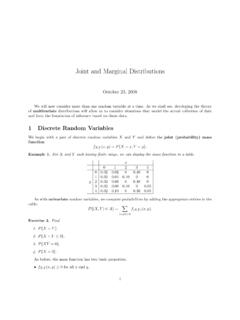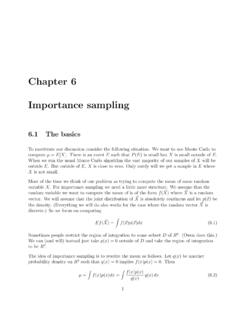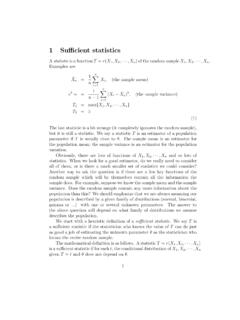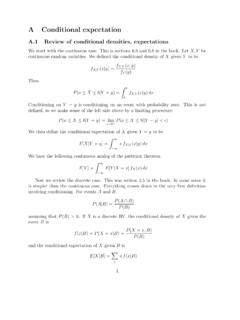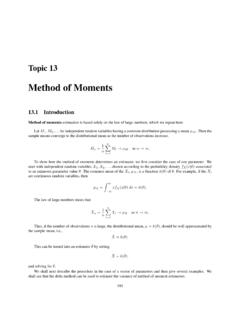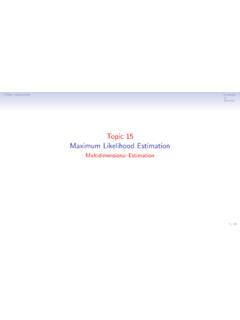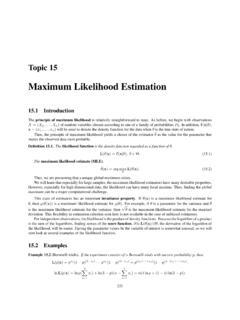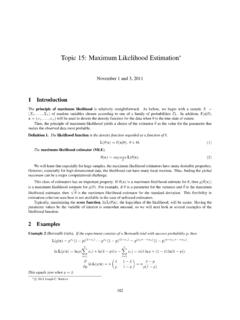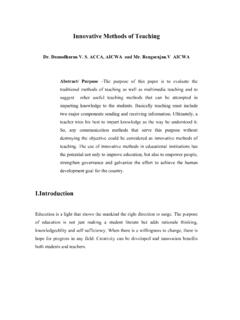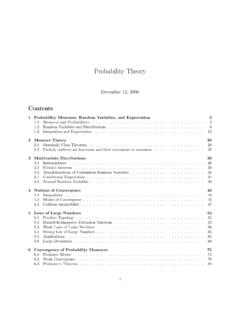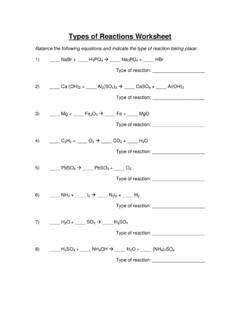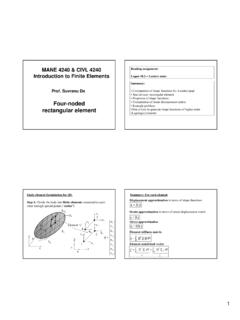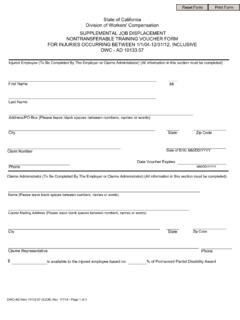Transcription of Section 13.1: Displacement Vectors - University of Arizona
1 Section : Displacement VectorsA Displacement vector is a geometric object which encodes both a Displacement and a vectorfrom one point to another is an arrow with its tail at the first pointand its tip at the second. Themagnitude(or length) of the Displacement vector is the distancebetween the points and is represented by the length of the arrow. Thedirectionof the displacementvector is the direction of the : Displacement Vectors which point in the same direction and have the same magnitude areconsidered to be the same, even if they do not and Terminology:There are mainly two types of quantities we concern ourselves with: Vectors and scalars. As you have seen, avectorhas both magnitude and direction. Ascalar, on theother hand, is a quantity specified only by a number, and has no the course, we will denote Vectors with an arrow.
2 For example,~vis a vector. A scalarwill be denoted by simple italics. At times, we will use the notation~PQto denote the displacementvector from pointPto and Subtraction of Vectors :The addition of two Vectors can be easily that you start at a specific point and then move 25 feet to the east, then 25 feet north. Yourdisplacement is then 25 2 feet in a direction of 45 with respect to the ,~v+~w, of two Vectors ~v ~wis the combined Displacement resulting from first applying~vand then~w. The sum~w+~vgives the same ,~w ~v, is the Displacement vector that, when added to~v, gives~w. That is,~w=~v+ (~w ~v).Thezero vector,~0, is a Displacement vector with zero Multiplication of Displacement VectorsThe basic premise is this: if we multiply a vector by a scalar quantity, we transform the length of thevector by that specific factor.
3 For example,aIf is a scalar and~vis a Displacement vector, thescalar multiple of~vby , written ~v, is thedisplacement vector with the following properties: The Displacement vector ~vis parallel to~v, pointing in the same direction if >0 and inthe opposite direction if <0. The magnitude of ~vis| |times the magnitude of~v, that is,|| ~v||=| |||~v||.3 Components of Displacement Vectors : The Vectors ~i,~j, and~kThe Vectors ~i,~j, and~kareunit Vectors , that is Vectors of length 1, that point in the directions ofthe positivex-axis,y-axis, andz-axis, respectively. Using vector addition, we can write any vector as asum of scalar multiples of~i,~j, and~k. This is especially easy to visualize in two dimensions:In the picture above, the Displacement vector fromPtoQis 4~i ~ of what we do in this course will take place in three-dimensional Euclidean space (R3).
4 Wewill coverR3in more detail once we get to chapter 12. For now, just imagine taking thexy-plane andattaching a third axis, thez-axis, in a direction perpendicular to both thexandyaxis and such thatthez-axis points along the length of your thumb if you curl your right hand in the direction from thex-axis to they-axis. In such a three-dimensional coordinate system, the Vectors ~i,~j, and~kcan bevisualized as follows:Weresolve~vinto components by writing~vin the form~v=v1~i+v2~j+v3~k,wherev1,v2,v3are scalars. We callv1~i,v2~k, andv3~kthecomponentsof~ Alternative Notation for VectorsOften you will see the vector~v=v1~i+v2~j+v3~kwritten in the form~v= v1,v2,v3 ,or even sometimes as~v= (v1,v2,v3).We will often use the notation v1,v2,v3 in this :1.
5 Resolve the Vectors pictured below into components5 Components of Displacement VectorsThe Displacement vector from the pointP1= (x1,y1,z1) to the pointP2= (x2,y2,z2) is given incomponents by~P1P2= (x2 x1)~i+ (y2 y1)~j+ (z2 z1)~kPosition Vectors : Displacement of a Point from the OriginA Displacement vector whose tail is at the origin is called aposition vector. This creates a one-to-onecorrespondence between points (x0,y0,z0) inR3and Vectors ~r0according to~r0=x0~i+y0~j+z0~ Magnitude of a Vector in ComponentsThe magnitude of a vector can be easily computed using the Pythagorean TheoremMagnitude of~v= ~v = Length of arrow = v21+v22+v236 Addition and Scalar Multiplication of Vectors in ComponentsAddition and scalar multiplication of Vectors inR2orR3is performed component by , if~v=v1~i+v2~j+v3~kand~w=w1~i+w2~j+w3~k, and if is any scalar, we have~v+~w= (v1+w1)~i+ (v2+w2)~j+ (v3+w3)~kand ~v= v1~i+ v2~j+ v3~kHow to Resolve a Vector into ComponentsSuppose you have a 2-dimensional vector,~v, and you are given that~vhas length ~v =vand that~vmakes an angle of with thex-axis, measured counterclockwise.
6 If~v=v1~i+v2~j, VectorsSimply put, aunit vectoris a vector whose magnitude is equal to 1. The Vectors ~i,~j, and~kareexamples of unit Vectors that we have already is a relatively simple matter to find a unit vector that points in the same direction as an arbitraryvector~v. For example, suppose that ~v = 10. Then the vector~u=~v/10 has length 1 and points inthe same direction as~ general, a unit vector in the direction of any given nonzero vector~vis given by~u=~v ~v Examples:2. Perform the indicated operation:12(2~i ~j+ 3~k) + 3(~i 16~j+12~k)3. (a) Draw the position vector for~v= 5~i 7~j(b) What is ~v ?(c) Find the angle between~vand the Find the unit vector in the opposite direction to~i ~j+~k5. Find a vector of length 2 that points in the same direction as~i ~j+ 2~k6.
7 Find the value(s) ofamaking~v= 5a~i 3~jparallel to~w=a2~i+ 6~j7. (a) Find a unit vector from the pointP= (1,2) and toward the pointQ= (4,6)(b) Find a vector of length 10 pointing in the same Resolve the following Vectors into components(a) The vector in 2-space of length 2 pointing up and to the right at an angle of /4 with thex-axis.(b) The vector in 3-space of length 1 lying in thexz-plane pointing upward at an angle of /6with the positivex-axis.
